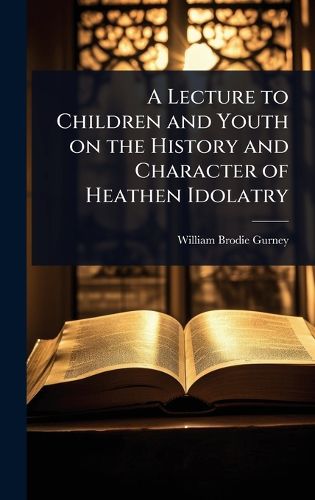Readings Newsletter
Become a Readings Member to make your shopping experience even easier.
Sign in or sign up for free!
You’re not far away from qualifying for FREE standard shipping within Australia
You’ve qualified for FREE standard shipping within Australia
The cart is loading…






This title is printed to order. This book may have been self-published. If so, we cannot guarantee the quality of the content. In the main most books will have gone through the editing process however some may not. We therefore suggest that you be aware of this before ordering this book. If in doubt check either the author or publisher’s details as we are unable to accept any returns unless they are faulty. Please contact us if you have any questions.
"A Lecture to Children and Youth on the History and Character of Heathen Idolatry" by William Brodie Gurney, first published in 1848, offers a detailed exploration of idolatry across various ancient cultures. Gurney examines the practices and beliefs associated with deities such as Moloch, Baal, Dagon, and Woden, drawing upon historical accounts and biblical references. He contrasts these 'heathen' traditions with the teachings of Jesus Christ and the gospel.
The lecture provides insights into the religious customs of ancient Egypt, the South Sea Islands, and other regions, highlighting the perceived moral implications of these practices. Gurney's work reflects the perspective of a 19th-century Baptist Missionary Society member, aiming to educate young audiences about the perceived dangers of idolatry and the importance of Christian faith.
This work has been selected by scholars as being culturally important, and is part of the knowledge base of civilization as we know it. This work was reproduced from the original artifact, and remains as true to the original work as possible. Therefore, you will see the original copyright references, library stamps (as most of these works have been housed in our most important libraries around the world), and other notations in the work.
This work is in the public domain in the United States of America, and possibly other nations. Within the United States, you may freely copy and distribute this work, as no entity (individual or corporate) has a copyright on the body of the work.
As a reproduction of a historical artifact, this work may contain missing or blurred pages, poor pictures, errant marks, etc. Scholars believe, and we concur, that this work is important enough to be preserved, reproduced, and made generally available to the public. We appreciate your support of the preservation process, and thank you for being an important part of keeping this knowledge alive and relevant.
$9.00 standard shipping within Australia
FREE standard shipping within Australia for orders over $100.00
Express & International shipping calculated at checkout
Stock availability can be subject to change without notice. We recommend calling the shop or contacting our online team to check availability of low stock items. Please see our Shopping Online page for more details.
This title is printed to order. This book may have been self-published. If so, we cannot guarantee the quality of the content. In the main most books will have gone through the editing process however some may not. We therefore suggest that you be aware of this before ordering this book. If in doubt check either the author or publisher’s details as we are unable to accept any returns unless they are faulty. Please contact us if you have any questions.
"A Lecture to Children and Youth on the History and Character of Heathen Idolatry" by William Brodie Gurney, first published in 1848, offers a detailed exploration of idolatry across various ancient cultures. Gurney examines the practices and beliefs associated with deities such as Moloch, Baal, Dagon, and Woden, drawing upon historical accounts and biblical references. He contrasts these 'heathen' traditions with the teachings of Jesus Christ and the gospel.
The lecture provides insights into the religious customs of ancient Egypt, the South Sea Islands, and other regions, highlighting the perceived moral implications of these practices. Gurney's work reflects the perspective of a 19th-century Baptist Missionary Society member, aiming to educate young audiences about the perceived dangers of idolatry and the importance of Christian faith.
This work has been selected by scholars as being culturally important, and is part of the knowledge base of civilization as we know it. This work was reproduced from the original artifact, and remains as true to the original work as possible. Therefore, you will see the original copyright references, library stamps (as most of these works have been housed in our most important libraries around the world), and other notations in the work.
This work is in the public domain in the United States of America, and possibly other nations. Within the United States, you may freely copy and distribute this work, as no entity (individual or corporate) has a copyright on the body of the work.
As a reproduction of a historical artifact, this work may contain missing or blurred pages, poor pictures, errant marks, etc. Scholars believe, and we concur, that this work is important enough to be preserved, reproduced, and made generally available to the public. We appreciate your support of the preservation process, and thank you for being an important part of keeping this knowledge alive and relevant.